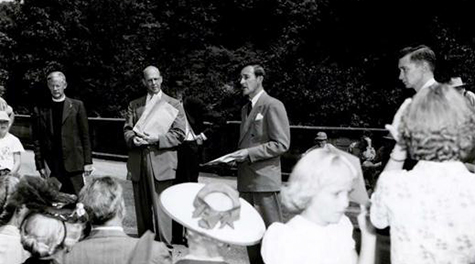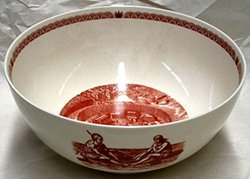Cherokee Clay
 Georgia potter Andrew Duche first made porcelain in 1739 after discovering the essential ingredients in porcelain, kaolin and petunze, in the clay found in Cherokee Indian country near present-day Franklin. English potter Josiah Wedgwood learned of the so-called Cherokee clay and requested a sample in 1766. Unsuccessful in his request, Wedgwood commissioned Thomas Griffiths to obtain some of the clay. Griffiths brought five tons of Cherokee clay to London in April 1768. Wedgwood took out a patent for encaustic ornamentation using the clay in 1769. Wedgwood's supply lasted at least until 1783, when he wrote that Cherokee clay was the basis for the new biscuit porcelain (jasper) he was making. The discovery of suitable clay in Cornwall, England, ended the demand for more Cherokee clay. However, in the summer of 1985, the Wedgwood firm in England received additional Cherokee clay from western North Carolina to cast limited edition bowls and plates commemorating the 400th anniversary of English colonization efforts on Roanoke Island.
Georgia potter Andrew Duche first made porcelain in 1739 after discovering the essential ingredients in porcelain, kaolin and petunze, in the clay found in Cherokee Indian country near present-day Franklin. English potter Josiah Wedgwood learned of the so-called Cherokee clay and requested a sample in 1766. Unsuccessful in his request, Wedgwood commissioned Thomas Griffiths to obtain some of the clay. Griffiths brought five tons of Cherokee clay to London in April 1768. Wedgwood took out a patent for encaustic ornamentation using the clay in 1769. Wedgwood's supply lasted at least until 1783, when he wrote that Cherokee clay was the basis for the new biscuit porcelain (jasper) he was making. The discovery of suitable clay in Cornwall, England, ended the demand for more Cherokee clay. However, in the summer of 1985, the Wedgwood firm in England received additional Cherokee clay from western North Carolina to cast limited edition bowls and plates commemorating the 400th anniversary of English colonization efforts on Roanoke Island.
References:
William L. Anderson, "Cherokee Clay, from Duche to Wedgwood: The Journal of Thomas Griffiths, 1767-1768," NCHR 63 (October 1986).
Ann Finer and George Savage, eds., The Selected Letters of Josiah Wedgwood (1965). 
Additional Resources:
"Pottery Clay." North Carolina Highway Historical Marker Program. https://www.ncdcr.gov/about/history/division-historical-resources/nc-highway-historical-marker-program/Markers.aspx?ct=ddl&sp=search&k=Markers&sv=Q-36 (accessed November 7, 2012).
Frankenberg, Dirk. "White clay and Wedgwood pottery." Clays of the Piedmont. LearnNC.org. http://www.learnnc.org/lp/editions/cede_piedclay/241 (accessed November 7, 2012).
Wedgwood, Hensleigh C. "A Mission For Mr. Wedgwood." American Heritage 21. Issue 5. August 1970. http://www.americanheritage.com/content/mission-mr-wedgwood (accessed November 7, 2012).
Meteyard, Eliza. "Chapter 1: Materials and Mechanical Aids." The Life of Josiah Wedgwood: From His Private Correspondence and Family Papers ... with an Introductory Sketch of the Art of Pottery in England Volume 2. London: Hurst and Blackett, 1866. http://books.google.com/books?id=KpxGAAAAMAAJ&pg=PA3#v=onepage&q&f=false (accessed November 7, 2012).
Ellison, George. "Region’s kaolin history is nearly forgotten." Smokey Mountain News. October 20, 2010. http://www.smokymountainnews.com/index.php/component/k2/item/2128-region%E2%80%99s-kaolin-history-is-nearly-forgotten (accessed November 7, 2012).
Mercer,Gordon and Mercer, Marcia. "Wedgwood Pottery: Early Cherokee Unaker Mining in Franklin, NC" Small Business Newswire. April 27, 2012. http://www.sbwire.com/press-releases/wedgwood-pottery-early-cherokee-unaker-mining-in-franklin-nc-139324.htm (accessed November 7, 2012).
W. Ross Ramsay, Judith A. Hansen, and E. Gael Ramsay. An "A-Marked" Porcelain Covered Bowl, Cherokee Clay, and Colonial America's Contribution to the English Porcelain Industry." Ceramics in America. 2004. http://www.chipstone.org/publications/CIA/2004/ramsay/ramsayindex.html (accessed November 7, 2012).
Griffiths, Thomas. 1767. Thomas Griffiths journal. https://www.worldcat.org/oclc/26380274 (accessed November 7, 2012).
Image Credits:
"Photograph, Accession #: H.1950.62.8." 1950. North Carolina Museum of History.
Wedgwood/Ivey's. "Bowl, Accession #: H.2006.23.200." 1985. North Carolina Museum of History.
1 January 2006 | Anderson, William L.